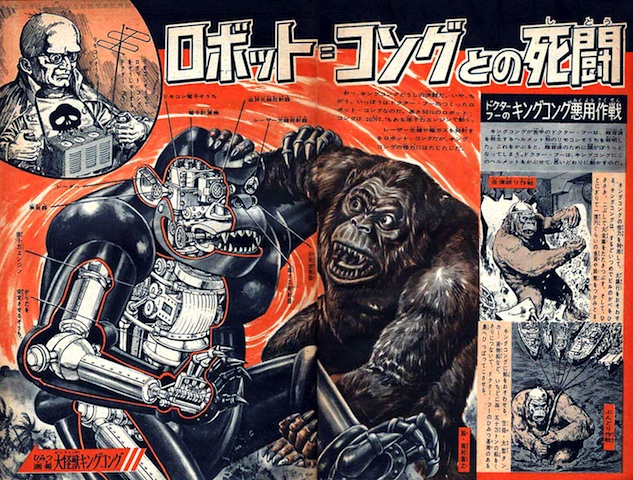
Back in the day some guy named Cooper had this crazy idea for a film involving a giant ape. He got a guy named O’Brien to help make it happen, with some stop-motion animation that blew audiences out of their seats. Cooper made a few more films in the same vein, then the big monster genre kind of disappeared.
Twenty years passed. All those kids who experienced King Kong in cinemas grew up. Some of them became filmmakers. One of them, a guy called Honda, made a King Kong of his own, a little film called Gojira. Audiences went wild. The American film industry got a taste, but, brows held high, passed the genre gingerly down to their scrappy B-picture men. One of Ray Bradbury’s childhood friends, who had spent some quality time with O’Brien back in the day, started making little indie monster pictures of his own. The Japan film industry, on the other hand, knew a good thing when they saw it, and proceeded to make hundreds of giant monster films, or Kaiju, lavishing huge budgets, quality art design and great actors on the proceedings. Sometimes even the great Kurosawa had to wait for his actors to finish playing twisted mad scientists or brave aviator explorers before he could shoot his own masterpieces. But he was okay with this.
It seems Japan never understood the difference between low and high art. For them, anything could be a great work of art with enough effort. True, a lot of the Kaiju that flooded the market wasn’t very good, but some of it was. Japanese films like Godzilla Raids Again and Mothra Vs. Godzilla captured the souls of its people as well as entertaining them with monster-on-monster battles royale.
In America, things weren’t so great. Bradbury’s friend Harryhausen made films that were cheaply shot and poorly acted and contained the best stop-motion animation ever rendered on film. His wonderful work was forever tarnished due to crippling budget restrictions. While Japanese filmmakers were shooing men in rubber suits so effectively that they sometimes actually looked like giant beasts, the only monster suits in US releases were so ridiculous that people are still laughing to this day. To top all this, small US film companies were buying up Kaiju, editing in poorly shot scenes with bad American actors, and stripping out the original audio to replace it with terrible dubbing and awful stock music. Great art was turned into rubbish and US audiences pointed and laughed and thought “look, those guys are just as cheesy as we are.”
Years passed. Lucas and Spielberg, the first working film students, came along and helped prove, as the Japanese had already done decades ago, that genre films can be art. Star Wars, Indiana Jones, Jaws etc. took the monster/sci-fi mantle from the indie crowd and turned it back over to the blockbuster Hollywood where it began. Home video was invented. Suddenly western cinephiles got to see Kaiju films in all their unedited, un-dubbed glory, and their opinions quickly changed.
And here I sit with a stack of old Kaiju I got from the used bin at FYE. And I watch King Kong Escapes slack jawed with awe, and I watch Ghidora The Three Headed Monster and gasp and laugh. And I watch the horribly mangled American release of Gammera The Invincible and it’s actually still pretty cool. Back in the day the West met the East and the East met the West and everything kind of exploded and we’re still feeling the aftershocks and I’m sitting here admiring the lovely miniature house that Godzilla is about to step on and thinking, how do I get in on this?!
Note: I’m indebted to David Kalat and his succinct commentary on the Toho Master Collection edition of Ghidora The Three Headed Monster for the inspiration for this piece. Thanks Dave. I plan to read your book soon.
